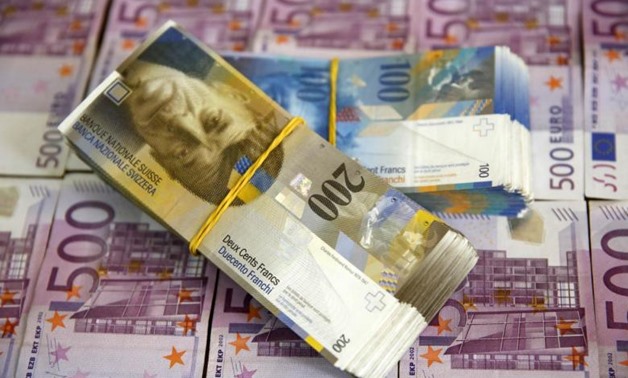
A picture illustration of Swiss Franc and Euro banknotes taken in central Bosnian town of Zenica - REUTERS
LONDON - 16 January 2018: The euro slipped against the dollar and the pound on Wednesday as worries about the outlook of the euro zone economy weighed on the single currency while sterling edged higher before a no-confidence vote on Prime Minister Theresa May’s government.
Prime Minister Theresa May’s government faced the vote on Wednesday after the crushing defeat of her Brexit divorce deal by parliament left Britain’s exit from the European Union in disarray just 10 weeks before it is due to leave.
Though the pound had sunk more than 1 percent against the dollar earlier on Tuesday, it rallied back after the parliamentary vote, with the sizable defeat for May seen forcing Britain to pursue different options.
“The risk of a no-deal exit has increased slightly, but counterbalancing that the fact that (Labour leader Jeremy) Corbyn has called a no-confidence vote has increased the chance of a second referendum,” said Adam Cole, chief currency strategist at RBC.
“If Labour loses the confidence vote as expected, that takes the election off the table and puts focus on second referendum,” he said.
As a consequence, the single currency fell as much as 0.3 percent against the pound hitting a seven-week low of 88.44 pence.
The euro had already been hit earlier this week, as data showed Germany barely escaped a recession in the second half of 2018 and European Central Bank chief Mario Draghi warned the euro zone economy was weaker than expected.
On Brexit, a high degree of uncertainty has to be factored into market projections, others warned.
“Everything remains possible: new elections, an extension of the deadline for Article 50, or even a second referendum,” said Stefan Kreuzkamp, chief investment officer at DWS.
“Like many of our peers, we continue to hope for an orderly exit of the United Kingdom from the EU. But the path to get there remains unclear, and in any case cobbled with plenty of hurdles.”
The dollar eased 0.1 percent to 108.56 yen after advancing 0.5 percent against its Japanese peer overnight amid a further ebb in risk aversion with U.S. stocks posting strong gains.
The Swiss franc, which tends to gain in times of political tensions and market turmoil along with the yen, was flat at 0.9879 franc per dollar.
The dollar index against a basket of six major currencies was marginally lower at 95.982 after climbing almost 0.5 percent the previous day, when it brushed an 11-day high of 96.261.
“A recovery by U.S. equities and a resulting ebb in downward pressure on Treasury yields will widen interest rate differentials between the United States and other countries. This will be a theme supporting the dollar this year,” said Junichi Ishikawa, senior FX strategist at IG Securities in Tokyo.
Long-term U.S. Treasury yields dropped to an 11-month low of 2.543 percent at the start of January but have bounced back above 2.70 percent, as the broader equity markets have regained some calm after experiencing a heavy round of risk aversion seen at the turn of the year.
The Australian dollar was flat at $0.72055 after dipping 0.2 percent on Tuesday.


Comments
Leave a Comment